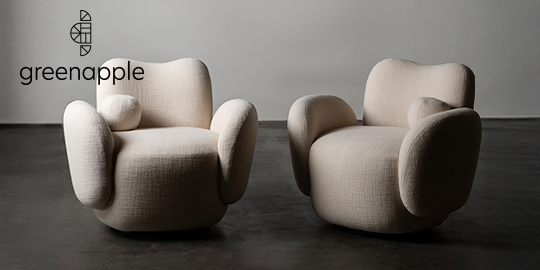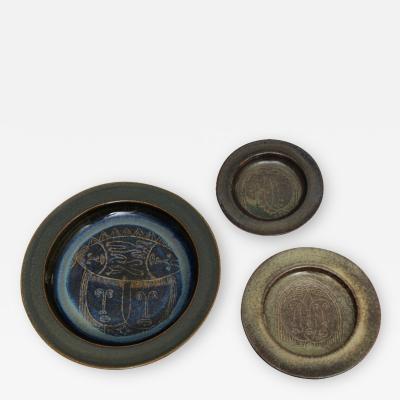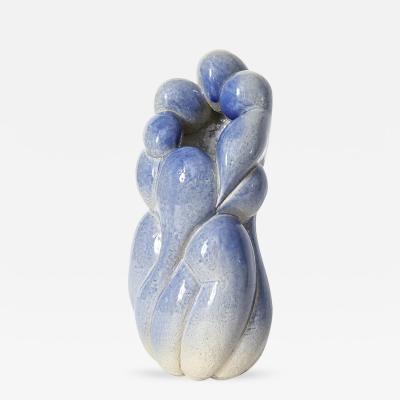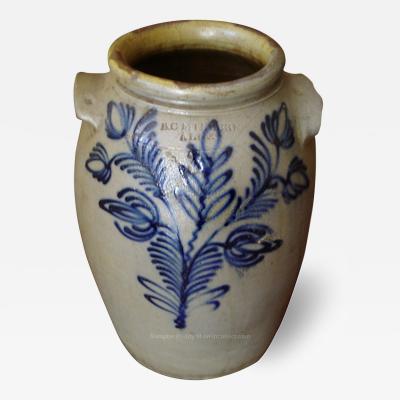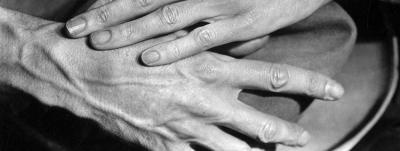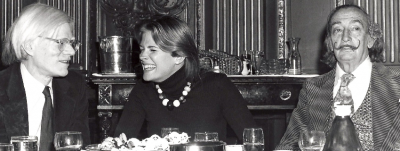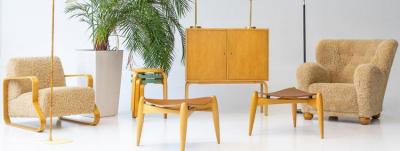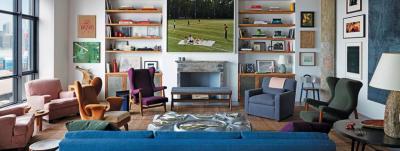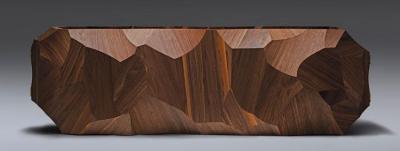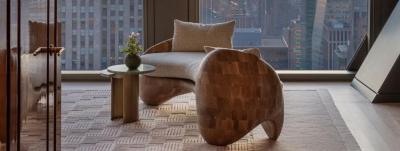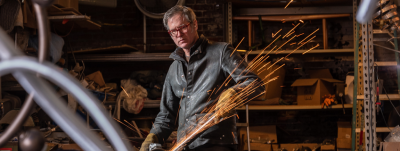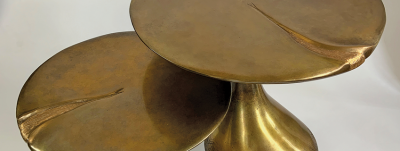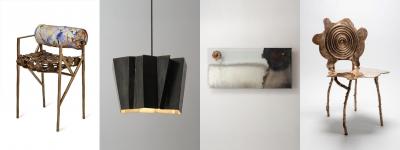Groundbreaking Modern Ceramics of Edwin and Mary Scheier
 | |
Partners in life and work, Edwin Scheier and Mary Goldsmith Scheier were leaders in the studio pottery revival that was part of the mid-century modern design movement made up of artists, designers, and architects whose work blurred the line between art and crafts (Fig. 1). These self-taught potters, working independently and collaboratively, produced award-winning studio ceramics over many decades. During their twenty-eight years in Durham, New Hampshire, the Scheiers became two of the state’s most famous artists (Fig. 2).
Mary Goldsmith Scheier (1910–2007) was born into a comfortable middle-class family in Virginia, and studied art at the Grand Central School of Art, the New York School of Fine and Applied Art, and in Paris. In 1935, she returned to Virginia as director of Big Stone Gap and Abingdon Art Centers. Edwin Scheier (1910–2008) grew up in Brooklyn, New York, and struck out early on his own to escape a less than happy family life. He apprenticed in turn with a silversmith, an Austrian ceramicist, and a Sicilian puppeteer. During the Great Depression years, the WPA traveled his puppet show to New York State, where he also taught craft classes. In 1937, working as a WPA field supervisor in Virginia, he met Mary. After their marriage the same year they went on the road with their traveling show, the Pop-Up Puppets, using their own handmade puppets, until Ed took a job as an art director in Norris, Tennessee. In Norris, the Scheiers were given the use of the Tennessee Valley Authority’s Ceramic Laboratory in exchange for managing the night firing shift. By night, they experimented with clay, glazes, and techniques, keeping their daytime teaching jobs.
In 1938, The Scheiers moved to Glade Spring, Virginia, and began their own pottery business, Hillcrock Pottery. They made pottery wheels from parts of their Model-T car and a sewing machine, and built a traditional folk kiln. They were attending the American Ceramic Society’s conference in Black Mountain, North Carolina, in 1940, when they met David R. Campbell, director of the League of New Hampshire Arts and Crafts. Founded in 1932, the League (now the League of New Hampshire Craftsmen) was created as part of an initiative by the state’s Governor John Winant to establish training programs and market local crafts to boost the state’s economy during the Depression years. In 1939, the League had established the Pottery Center at the University of New Hampshire at Durham, offering “vocational training in the manufacturing of pottery” under the home economics department. Similar craft training in enameling and metal work was later established at Plymouth State College. To teach several of these innovative programs, League director David Campbell reached beyond state lines, inviting Ed and Mary Scheier to lead the University of New Hampshire ceramics program at Durham.
 | |
Ed taught ceramics at UNH from 1940 to 1960. As artist-in-residence, Mary shared a campus studio and replaced her husband during his service in World War II. Here, they matured as professional artists, inventing the art that is recognizably “Scheier”: Mary’s functional ware and Ed’s ceramic canvases (vases, platters, and sculpture). Stylistically, the earliest influences in the Scheiers’ work came from the mountain folk potters they met in North Carolina and Tennessee. “We learned a lot from them…They were very sweet people. One potter used to grind Milk of Magnesia bottles to get his glaze, a nice glaze,” Ed Scheier later reminisced.1
As collaborative artists, Mary Scheier threw most of the small pottery and Ed did most of the glazing (Fig. 3), while both had distinctive decorating styles. Mary produced fine functional ware, influenced equally by traditional Chinese and Japanese ceramics and by Virginia folk potters. She was known for her thin-walled, elegant forms that were often decorated with fine freehand brushwork. From 1940 to the late 1960s, she produced thousands of pieces of pottery for everyday use that she referred to as her “boiler plates.” These were primarily sold through the League of New Hampshire Craftsmen (Fig. 4). Large vessels and platters from this period were made entirely by Ed and were sculptural expressions of his decades-long exploration of human behavior through biblical themes. Subjects such as Adam and Eve, temptation, birth, and motherhood seem curious to some because the Scheiers were not religious and had no children (Fig. 5). Ed refused to analyze his work, “I don’t know why, and don’t particularly want to know why I have stuck on this theme. If I knew why, I wouldn’t do it anymore,” he said in 1993.
 |  | |
The couple participated in numerous group and solo exhibitions, and won awards most of the years they submitted pieces to the Ceramic Nationals and other high profile, juried exhibitions. Mary made several of the winning pieces. A coffee set they entered in the 12th Ceramic National won for “best designed pottery suitable for mass production.” In 1956, the couple won the coveted Medal of Award from the Society of Arts and Crafts of Boston.
Primitive imagery from Africa and pre-Columbian art of Mexico and Guatemala interested Ed Scheier throughout his career. But Abstract Expressionism and Surrealism, particularly the work of Paul Klee, Jackson Pollack, and Hans Hoffman (from whom Ed Scheier took classes in the 1940s), also found their way into his art (Fig. 6). As a member of the UNH art department, Ed explored painting and, in the early 1950s, he was juried into the annual New Hampshire Art Association’s Currier exhibitions. In 1954 he made his first rug design and, in 1959, after a sabbatical in Mexico, Ed exhibited Mexican woven rugs of his design at Exeter’s Lamont Gallery and Sharon Art Center (Fig. 7).
 |  | |
 |  | |
 |  | |
 | |
| Fig. 11: Ink jet print, untitled, made between 2000 and 2001. Courtesy of UNH Special Collections. Photography by Ralph Morang. Ed Sheier’s inkjet prints are individually modeled and feel almost three-dimensional. | |
 | |
Despite their success, Ed and Mary Scheier were humble, generous, and well loved in their New Hampshire community. A former Durham neighbor recalled, “When my mother would bake cookies she would have me take some to Mary and Ed. After a few days, Mary would bring over one of her bowls and give it to my mother. My mother would say, “Mary, I can’t take your pottery,” to which Mary would reply, “We’re just exchanging baked goods.”
The Scheiers continued to live and work at their house in Durham for the next eight years, until 1968, when they retired to Oaxaca, Mexico. There, Mary stopped potting due to arthritis in her hands, while Ed concentrated his work in wood, tapestry, and painting. He also experimented with a soft local Guanacaste wood for his primitive figural sculpting (Fig. 8). Moving to Arizona in the 1990s, Ed found renewed inspiration in clay, creating some of his most exquisite work during this period. Where his early sgraffito designs and relief work was often applied to smooth vessels and bowls (fig.1, Fig. 9), his bold sculptured surfaces of the 1960s were resumed in the 1990s with new flair. Imagery was pushed and pulled to form lively relief surfaces often with corresponding inside details (Fig.10). For his platters, he returned to themes about Adam and Eve. When he could no longer throw pots due to his age, Ed learned how to use a computer and found another way to express his familiar motifs: ink jet prints (Fig.11).
As the artists aged, they made arrangements for the future. In 1968 they made a major gift to the University of New Hampshire of his ceramics (Fig. 12). The Scheier’s estate, which included their own work as well as that of many of their artist friends, was left to the Currier Museum of Art. The museum had early recognized the Scheiers in a series of important exhibitions. In 1988, the Currier also inherited the Manchester home of one of the Scheier’s many collectors. The Isadore and Lucille Zimmerman House, designed by Frank Lloyd Wright, is filled with ceramics by these important and dedicated artists.
Dale Valena is curator of the University Museum in Dimond Library, University of New Hampshire. Richard M. Candee is past-professor emeritus of American and New England Studies at Boston University and past-president of the Portsmouth Historical Society.
This article was originally published in the Autumn 2015 issue of Antiques & Fine Art magazine, which was affiliated with Incollect.





